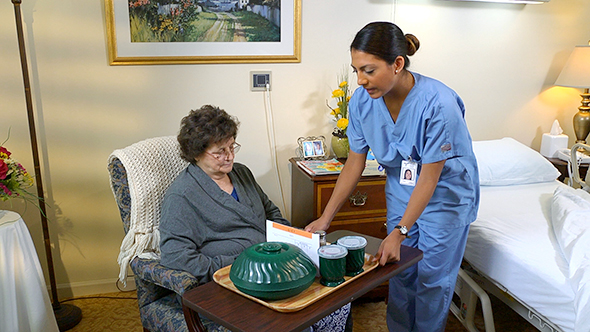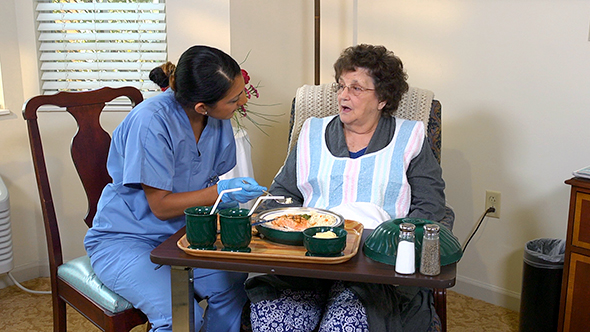Nutrition and Fluids
Select a Skill:
Take the Review Test:

Purpose

- Weakness, paralysis, casts, and other limits can make self-feeding impossible. These persons are fed.
- Serve foods and fluids in the order the person prefers. Offer fluids during the meal. Fluids help the person chew and swallow.
- Use teaspoons to feed the person. They are less likely to cause injury than forks. The teaspoon should only be one-third full. This portion is chewed and swallowed easily. Some people need smaller portions. Follow the care plan.
- Persons who need to be fed may be angry, embarrassed, depressed, resentful, or refuse to eat. Let them do what they can. Some can manage “finger foods” (bread, crackers). If strong enough, let them hold milk or juice cups (never hot drinks). Follow activity limits as ordered. Provide support. Urge them to try, even if food is spilled.
- For visually impaired persons, always describe what is on the tray and what you are offering. For persons who feed themselves, describe foods and fluids and their place on the tray. Use the numbers on a clock for food locations.
- Many people pray before eating. Allow time and privacy for prayer.
- Meals provide social contact. Engage the person in pleasant conversation, but allow time for chewing and swallowing. Also, sit facing the person. Sitting is more relaxing. Facing the person lets you see how well the person is swallowing and eating.
Equipment
Roll cursor over items to see labels. For the purposes of clearly depicting the equipment, a barrier is not shown in this photo. When providing care, a barrier should always be placed on the surface before placing the equipment.

Clothing protector
Meal tray with dietary card
Napkin and eating utensils
Straws
Two folders-flow sheet
Intake & output record
Kidney basin
Oral hygiene supplies
Hand washing supplies
Hand wipes
Wash basin
Cup
Delegation
- Follow delegation guidelines. Before assisting with eating, obtain this information from the nurse and care plan:
- The person’s food allergies, if any
- Why the person needs help
- How much help the person needs
- How to position the person
- If the person can manage finger foods
- The person’s activity limits
- The person’s dietary restrictions
- What size portion to feed the person—one-third teaspoonful or less
- Needed safety measures if the person has dysphagia
- If the person can use a straw
- What observations to report and record
- When to report observations
- What patient or resident concerns to report at once
Preparation

- Observe quality-of-life measures.
- Review the information under Delegation and Safety and Comfort.
- Position the person in a comfortable position for eating—usually sitting or high-Fowler’s. (Note: Some state competency tests require that the person sit upright at least 75 to 90 degrees.)
- Get the tray. Place the tray on the over-bed table or dining table where the person can reach it.
Safety

- Check food temperature. Very hot foods and fluids can burn the person.
- Prevent aspiration. Check the person’s mouth before offering more foods or fluids. The person’s mouth must be empty between bites and swallows.
Comfort
- The person will eat better if not rushed. Sit to show the person that you have time. Standing communicates that you are in a hurry.
- Wipe the person’s hands, face, and mouth as needed during the meal. Use the napkin. If necessary, use a wet washcloth. Then dry the person with a towel.
Procedure Video
Audio Description: OFFFollow-up Care

- Provide for comfort.
- Place the call light within reach.
- Raise or lower bed rails. Follow the care plan.
- Complete a safety check of the room.
- Return the food tray to the food cart.
- Practice hand hygiene.
Reporting/Recording
- Report and record your observations, including:
- The amount and kind of food eaten
- Complaints of nausea or dysphagia
- Signs and symptoms of dysphagia
- Signs and symptoms of aspiration
Review Questions
Select the best answer.
1. When assisting a visually impaired person with eating, which action is appropriate?
 Encourage the person to allow you to feed him or her.
Encourage the person to allow you to feed him or her. Identify the location of each food as if the plate were a clock.
Identify the location of each food as if the plate were a clock. Place each food in a separate container so it is easily located.
Place each food in a separate container so it is easily located. Serve one food at a time and describe the food as it is served
Serve one food at a time and describe the food as it is served
Select the best answer.
2. What is the correct way to feed a person who cannot feed himself or herself?
 Place 1/3 tsp of food in the mouth.
Place 1/3 tsp of food in the mouth. Place 1 to 2 tsp of food in the mouth.
Place 1 to 2 tsp of food in the mouth. Place 30 to 60 mL of liquid in the mouth, using a straw.
Place 30 to 60 mL of liquid in the mouth, using a straw. Place 1 Tbl of food in the mouth without touching the tongue.
Place 1 Tbl of food in the mouth without touching the tongue.
Select the best answer.
3. When feeding a person who is totally dependent, what should you do?
 Feed the person as quickly as possible to minimize fatigue.
Feed the person as quickly as possible to minimize fatigue. Encourage the person to allow a caregiver to feed him or her.
Encourage the person to allow a caregiver to feed him or her. Encourage the person to try self-feeding, even if food is spilled.
Encourage the person to try self-feeding, even if food is spilled. Make choices for the person so he or she doesn’t feel overwhelmed at mealtime.
Make choices for the person so he or she doesn’t feel overwhelmed at mealtime.
Select the best answer.
4. Why should you check the person’s mouth before offering more foods or fluids?
 To prevent aspiration
To prevent aspiration To avoid accidental tongue biting
To avoid accidental tongue biting To help the person eat more slowly
To help the person eat more slowly To allow time to wipe the hands and face
To allow time to wipe the hands and face
Select the best answer.
5. For a person with dysphagia, how should you assist with eating?
 Use a long straw for liquids.
Use a long straw for liquids. Give thickened liquid with a spoon.
Give thickened liquid with a spoon. Provide liquids, using an eyedropper.
Provide liquids, using an eyedropper. Ask the nurse about switching to IV nutrition.
Ask the nurse about switching to IV nutrition.
You have completed the Review Questions for this skill. To take the Review again select the Start Over button. To proceed to another skill select from the dropdown menu. Select the Home or Back button to proceed to the next section.

